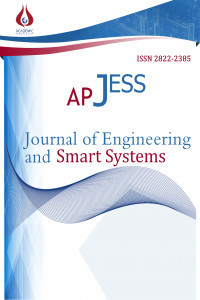A Novel Clustering-based Forecast Framework: The Clusters with Competing Configurations Approach
A Novel Clustering-based Forecast Framework: The Clusters with Competing Configurations Approach
___
- G. Pau, M. Collotta, A. Ruano, and J. Qin, “Smart Home Energy Management,” Energies (Basel), vol. 10, no. 3, p. 382, Mar. 2017, doi: 10.3390/en10030382.
- A. Iranpour Mobarakeh, R. Sadeghi, H. Saghafi esfahani, and M. Delshad, “Techno-economic energy management of micro-grid in the presence of distributed generation sources based on demand response programs,” International Journal of Electrical Power & Energy Systems, vol. 141, p. 108169, Oct. 2022, doi: 10.1016/j.ijepes.2022.108169.
- A. Shewale, A. Mokhade, N. Funde, and N. D. Bokde, “A Survey of Efficient Demand-Side Management Techniques for the Residential Appliance Scheduling Problem in Smart Homes,” Energies (Basel), vol. 15, no. 8, p. 2863, Apr. 2022, doi: 10.3390/en15082863.
- A. Kahraman, O. Bulut, E. Biyik, C. Guzelis, and G. Demirkiran, “Stochastic Microgrid Control Problems: Effects of Load Distribution and Planning Horizon,” in 2019 Innovations in Intelligent Systems and Applications Conference (ASYU), IEEE, Oct. 2019, pp. 1–6. doi: 10.1109/ASYU48272.2019.8946439.
- F. Agner, “Creating Electrical Load Profiles Through Time Series Clustering,” 2019.
- S. Yilmaz, J. Chambers, and M. K. Patel, “Comparison of clustering approaches for domestic electricity load profile characterisation - Implications for demand side management,” Energy, vol. 180, pp. 665–677, Aug. 2019, doi: 10.1016/j.energy.2019.05.124.
- K. Zhou, S. Yang, and Z. Shao, “Household monthly electricity consumption pattern mining: A fuzzy clustering-based model and a case study,” J Clean Prod, vol. 141, pp. 900–908, Jan. 2017, doi: 10.1016/j.jclepro.2016.09.165.
- G. Le Ray and P. Pinson, “Online adaptive clustering algorithm for load profiling,” Sustainable Energy, Grids and Networks, vol. 17, Mar. 2019, doi: 10.1016/j.segan.2018.100181.
- S. Lin, F. Li, E. Tian, Y. Fu, and D. Li, “Clustering load profiles for demand response applications,” IEEE Trans Smart Grid, vol. 10, no. 2, pp. 1599–1607, Mar. 2019, doi: 10.1109/TSG.2017.2773573.
- E. Mele, C. Elias, and A. Ktena, “Electricity use profiling and forecasting at microgrid level,” 2018.
- M. Alhussein, K. Aurangzeb, and S. I. Haider, “Hybrid CNN-LSTM Model for Short-Term Individual Household Load Forecasting,” IEEE Access, vol. 8, pp. 180544–180557, 2020, doi: 10.1109/ACCESS.2020.3028281.
- Y. Yang, W. Li, T. A. Gulliver, and S. Li, “Bayesian Deep Learning-Based Probabilistic Load Forecasting in Smart Grids,” IEEE Trans Industr Inform, vol. 16, no. 7, pp. 4703–4713, Jul. 2020, doi: 10.1109/TII.2019.2942353.
- C. Alzate and M. Sinn, “Improved electricity load forecasting via kernel spectral clustering of smart meters,” Proceedings - IEEE International Conference on Data Mining, ICDM, pp. 943–948, 2013, doi: 10.1109/ICDM.2013.144.
- T. K. Wijaya, M. Vasirani, S. Humeau, and K. Aberer, “Cluster-based aggregate forecasting for residential electricity demand using smart meter data,” in Proceedings - 2015 IEEE International Conference on Big Data, IEEE Big Data 2015, Institute of Electrical and Electronics Engineers Inc., Dec. 2015, pp. 879–887. doi: 10.1109/BigData.2015.7363836.
- A. Shahzadeh, A. Khosravi, and S. Nahavandi, “Improving load forecast accuracy by clustering consumers using smart meter data,” in 2015 International Joint Conference on Neural Networks (IJCNN), IEEE, Jul. 2015, pp. 1–7. doi: 10.1109/IJCNN.2015.7280393.
- S. Bandyopadhyay, T. Ganu, H. Khadilkar, and V. Arya, “Individual and aggregate electrical load forecasting: One for all and all for one,” in e-Energy 2015 - Proceedings of the 2015 ACM 6th International Conference on Future Energy Systems, Association for Computing Machinery, Inc, Jul. 2015, pp. 121–130. doi: 10.1145/2768510.2768539.
- F. Fahiman, S. M. Erfani, S. Rajasegarar, M. Palaniswami, and C. Leckie, “Improving load forecasting based on deep learning and K-shape clustering,” in Proceedings of the International Joint Conference on Neural Networks, Institute of Electrical and Electronics Engineers Inc., Jun. 2017, pp. 4134–4141. doi: 10.1109/IJCNN.2017.7966378.
- T. Jarabek, P. Laurinec, and M. Lucka, “Energy load forecast using S2S deep neural networks with k-Shape clustering,” in 2017 IEEE 14th International Scientific Conference on Informatics, IEEE, Nov. 2017, pp. 140–145. doi: 10.1109/INFORMATICS.2017.8327236.
- A. Cini, S. Lukovic, and C. Alippi, “Cluster-based Aggregate Load Forecasting with Deep Neural Networks,” in 2020 International Joint Conference on Neural Networks (IJCNN), IEEE, Jul. 2020, pp. 1–8. doi: 10.1109/IJCNN48605.2020.9207503.
- Y. Wang, Q. Chen, T. Hong, and C. Kang, “Review of Smart Meter Data Analytics: Applications, Methodologies, and Challenges,” IEEE Trans Smart Grid, vol. 10, no. 3, pp. 3125–3148, May 2019, doi: 10.1109/TSG.2018.2818167.
- S. Hochreiter and J. Schmidhuber, “Long Short-Term Memory,” Neural Comput, vol. 9, no. 8, pp. 1735–1780, Nov. 1997, doi: 10.1162/neco.1997.9.8.1735.
- Australian Government, “Smart Grid Smart City (SGSC). Customer trial data,” https://data.gov.au/dataset/ds-dga-4e21dea3-9b87-4610-94c7-15a8a77907ef/details, May 20, 2022.
- O. Motlagh, A. Berry, and L. O’Neil, “Clustering of residential electricity customers using load time series,” Appl Energy, vol. 237, pp. 11–24, Mar. 2019, doi: 10.1016/j.apenergy.2018.12.063.
- Yayın Aralığı: Yılda 3 Sayı
- Başlangıç: 2022
- Yayıncı: Akademik Perspektif Derneği
Ensar Arif SAĞBAŞ, Serkan BALLI
Optimizing PID Gains of a Vehicle using the state-of-the-art Metaheuristic Methods
Mustafa Atakan AFŞAR, Hilal ARSLAN
Is ChatGPT Leading Generative AI? What is Beyond Expectations?
A Novel Clustering-based Forecast Framework: The Clusters with Competing Configurations Approach
Gülçin DİNÇ YALÇIN, Tuğçe YAVUZ, Şüheda ALTINTAŞ
An Explorative Analysis of Tweets Sentiments for Investment Decision in Stock Markets
